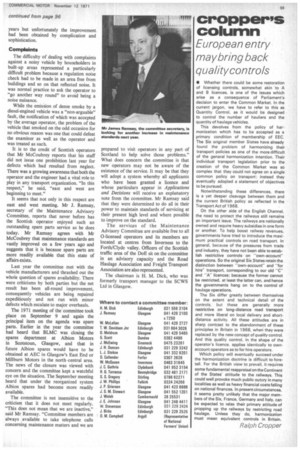cropper's column
Page 101

If you've noticed an error in this article please click here to report it so we can fix it.
European entry maybring back quafitycontrols
• Whether there could be some restoration of licensing controls, somewhat akin to A and B licences, is one of the issues which arise as a consequence of Parliament's decision to enter the Common Market. In the current jargon, we have to refer to this as Quantity Control, as it would be designed to control the number of hauliers and the quantity of haulage vehicles.
This devolves from the policy of harmonization which has to be accepted as a primary condition of membership of EEC. The Six original member States have already found the problem of harmonizing their transport policies as one of the more difficult of the general harmonization intention. Their individual transport legislation prior to the creation of the Common Market was so complex that they could not agree on a single common policy on transport : instead they eventually adopted a statement of objectives to be pursued.
Notwithstanding these differences, there is a yet deeper cleavage between them and the current British policy as reflected in the Transport Act of 1968.
On the other side of the English Channel. the need to protect the railways still remains an important issue. The railways are nationally owned and require heavy subsidies in one form or another. To help boost railway revenues, governments have tried to introduce the maximum practical controls on road transport. In general, because of the pressures from trade and industry, they have not been able to establish restrictive controls on "own-account" operations. So the original Six States retain the distinction between "own-account" and "for hire" transport, corresponding to our old "C" and -A" licences: because the former cannot be restricted, at least the latter can, and hence the governments hang on to the control of haulage operations.
The Six differ greatly between themselves on the extent and technical detail of the controls, but these are generally more restrictive on long-distance road transport and more liberal on local delivery and shortdistance activity. All these attitudes are in sharp contrast to the abandonment of these principles in Britain in 1968. when they were replaced by the new concept of quality control. And this quality control, in the shape of the operator's licence, applies identically to ownaccount operators as to for hire operators.
Which policy will eventually succeed under the harmonization doctrine is difficult to foretell For the British view to prevail, it requires some fundamental reappraisal on the Continent of the States' attitude to the railways. This could well provoke much public outcry in many localities as well as heavy financial costs falling on national finances. In present circumstances, it seems pretty unlikely that the major members of the Six, France. Germany and Italy, can be expected to relax their primary attitude of propping up the railways by restricting road haulage. Unless they do, harmonization must mean equivalent controls in Britain.










































































































































































































